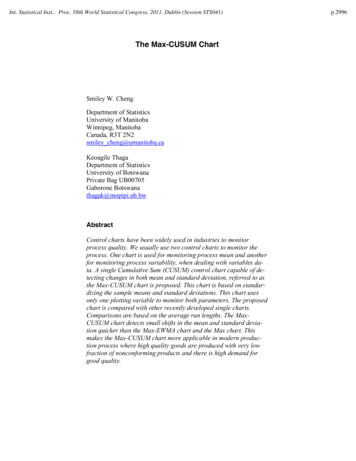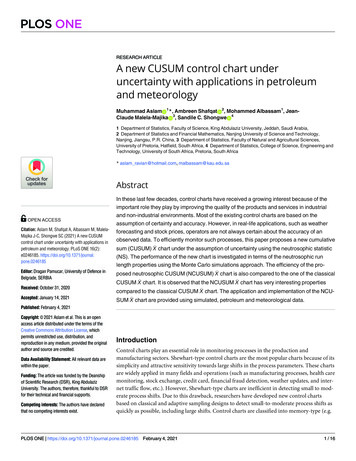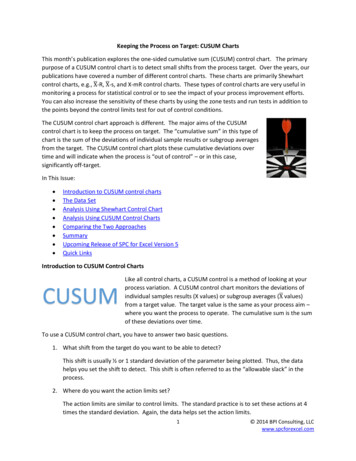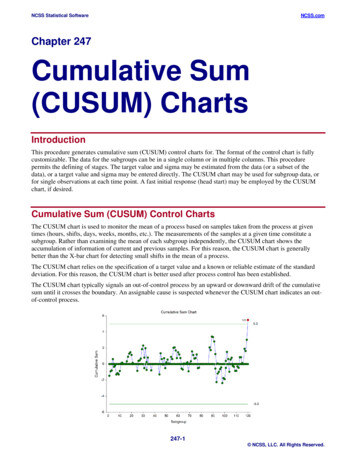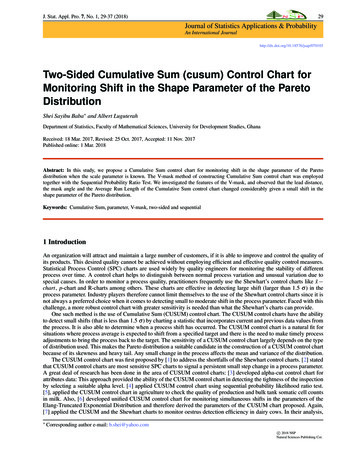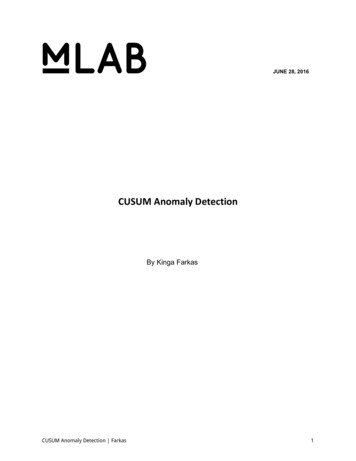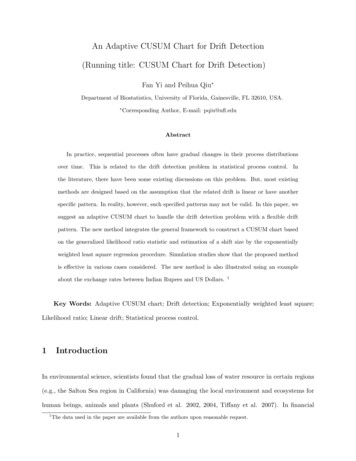
Transcription
The Use of a CUSUM Residual Chart to MonitorRespiratory Syndromic DataHuifen ChenDepartment of Industrial and Systems Engineering,Chung-Yuan University, Chung Li, TAIWAN; Email: huifen@cycu.edu.twChaosian HuangDepartment of Manufacturing, Lextar Electronics Corp., Hsinchu, TaiwanDecember 7, 2012AbstractWe construct a respiratory syndromic surveillance mechanism for the respiratory syndrome. The dataused for illustration are the daily counts of respiratory syndrome sampled from the National Health Insurance Research Database in Taiwan. The population size is 160,000. We first fit a regression model withan ARIMA (autoregressive integrated moving average) error term to the data and then construct CUSUM(cumulative sum) residual charts to detect the aberration in visit frequencies of respiratory syndrome. Theday-of-the-week, seasonal, and holiday effects are considered in the regression model. Our results showthat the CUSUM residual chart is useful in detecting abnormal increases of respiratory symptoms.Keywords: ARIMA; CUSUM chart; regression analysis; respiratory syndrome; syndromic surveillance;time series1IntroductionAn epidemic, or outbreak, means that the occurrence of a disease is at an unexpectedlyhigh frequency (Baxter et al., 2000). Recent epidemics, e.g., SARS in 2003, avian influenza in2003-2005 and H1N1 in 2009, have caused deaths of many people in the world. Early detectionof outbreaks is important for timely public health response to reduce morbidity and mortality.By early detecting the aberration of diseases, sanitarians can study or research into the causes ofdiseases as soon as possible and prevent the cost of the society and medical treatments. Traditional1
disease-reporting surveillance mechanisms might not detect outbreaks in their early stages becauselaboratory tests usually take long time to confirm diagnoses.Syndromic surveillance was developed and used to detect the aberration of diseases early(Henning, 2004). The syndromic surveillance mechanism is to collect the baseline data of prodromal phase symptoms and detect the aberration of diseases from the expected baseline by placingthe variability of data from the expected baseline. Such surveillance methods include the SPC(statistical process control) methods, scan statistics, and forecasting methods (Tsui et al. 2008).See Section 2 for literature review.In this work, we study the implementation of CUSUM (CUmulative SUM) residual chartfor detecting the outbreak of the respiratory syndrome in Taiwan. Since the daily visits of therespiratory syndrome are time series data with seasonal effect, we use a regression model with anARIMA (AutoRegressive Integrated Moving Average) error term to model the daily counts fromambulatory care clinic data. The CUSUM of residuals are then plotted in the CUSUM chart fordetecting unusual increase in daily visits. The test data are the 2005-2008 ambulatory care clinicdata from the National Health Insurance Research Database (NHIRD) in Taiwan.This paper is organized as follows. In Section 2, we review related literature. In Section 3, wesummarize the data, propose a regression model whose error term follows an ARIMA model, andconstruct the CUSUM chart using the residuals. The regression model is fitted to the daily countsdata of respiratory symptoms in years 2005 and 2006. In Section 4, we assess the performanceof the CUSUM residual chart by applying it to monitor the daily counts data in 2007 and 2008.The conclusion is given in Section 5.2Literature reviewWe discuss here the syndromic surveillance methods including the forecast-based, scan statis-tics, and SPC-based methods. Detailed reviews can be found in Tsui et al. (2008, 2011) andUnkel et al. (2012).The forecast-based methods are useful to model non-stationary baseline data. To detectaberration, an upper threshold value is determined using the fitted forecast model. When theactual value of the response variable exceeds the threshold, an outbreak alarm is sent. Twopopular forecasting methods are time-series and regression models. Goldenberg et al. (2002) usedthe AR (AutoRegressive) model to forecast the over-the-counter medication sales of the anthrax2
and built the upper prediction interval to detect the outbreak. Reis and Mandl (2003) developedgeneralized models for expected emergence-department visit rates by fitting historical data withtrimmed-mean seasonal models and then fitting the residuals with ARIMA models. Lai (2005)used three time series models (AR, a combination of growth curve fitting and ARMA error, andARIMA) to detect the outbreak of the SARS in China.The scan statistics have been widely used in retrospective detection of temporal clustering ofdiseases (Glaz et al. 2001). For example, Heffernan et al. (2004) applied the scan statistic methodto monitor respiratory, fever diarrhea and vomiting syndromes by the chief complaint data of theemergency department. This method scans a window of time; if an observed cluster of diseasesis significantly unusual for the underlying probability model, a signal is sent. Scan statistics arealso used for prospective detection of unusual clusters, where the time-window length can varyover a range of values (Kulldorff 2001, Naus and Wallenstein 2006).Recently the control charts have been applied in health-care and public-health surveillance(Woodall 2006). The SPC methods were first applied in the industrial statistical control (Montgomery 2005). Since the Shewhart chart is insensitive at detecting small shifts, CUSUM and exponentially weighted moving average (EWMA) charts are more commonly used in public-healthsurveillance than the Shewhart chart. Hutwagner et al. (1997) developed a computer algorithmbased on the CUSUM scheme to detect salmonella outbreaks using the laboratory-based data.Morton et al. (2001) applied Shewhart, CUSUM and EWMA charts to detect and monitorthe hospital-acquired infections. Their results showed that when used together, Shewhart andEWMA work well for monitoring bacteremia and multiresistant organism rates and that CUSUMand Shewhart charts are suitable for monitoring surgical infection.Modifications of CUSUM charts were proposed for the incidence rate with a changing population size. Some modifications are based on a Poisson model (e.g., Mei et al. 2011, Jiang et al.2012) and some are based on a Bernoulli model (e.g., Sego et al. 2008). If a Poisson model isused, the counts of incidents at regular time intervals are needed. The Bernoulli CUSUM chartcan detect increase in incidence rate earlier than the Poisson CUSUM chart because the BernoulliCUSUM chart monitors sequential Bernoulli data without waiting for aggregated counts (Shu etal. 2011).Some literature modeled the baseline data with a forecast model before applying an SPCscheme because the baseline data may not be independent and identically distributed and the meanof the data may be a function of time. Rogerson and Yamada (2004) applied a Poisson CUSUM3
residual chart to detect the lower respiratory tract infections for 287 census tracts simultaneously,where the baseline data were fitted by logistic regression models. Miller et al. (2004) used theregression model with autoregressive error to fit the influenzalike illness data in an ambulatorycare network, where the regression terms include weekend, holiday and seasonal adjustments (sineand cosine functions). They then used the standardized CUSUM residual chart for detectingthe outbreak. Fricker et al. (2008) applied the adaptive regression model with day-of-the-weekeffects using an 8-week sliding baseline and then used the CUSUM chart of the adaptive regressionresiduals. They showed that this approach performed better than the Early Aberration ReportingSystem (EARS) for baseline data with day-of-the-week effects.Literature comparing the three types of methods exists. Cowling et al. (2006) compared timeseries, regression, and CUSUM models using influenza data from Hong Kong and the US. Theyfound that the time series model was the best in the Hong Kong setting, while both the timeseries and CUSUM mod the-week effect. Our numerical results, however, show that the model for weekly countsis not much simpler. Since the weekly data are not as effective to identify outbreaks as dailydata, this work chooses to use the daily data.2. Our fitted regression model is based on historical data of the past two years. The timewindow can be longer so that more data can be used for model fitting. The shortage thoughis that the coefficient estimates would have larger variance and hence the prediction intervalwould be wider. Furthermore, the behavior of daily counts may not be the same each year,using historical data that are long ago may hurt the prediction accuracy for the futureobservations.3. In this work, some interaction terms can not be included in the regression model because of12
lack of data. To overcome this situation, one way is to include more historical data for modelfitting. The payoff is inducing more variation in parameter estimates as discussed in theprevious issue. Another way is to modify the regression model based on expert experiencesso that the interaction terms with no data can be included in the model.AcknowledgmentsThis study is based in part on data from the National Health Insurance Research Databaseprovided by the Bureau of National Health Insurance, Department of Health and managed byNational Health Research Institutes in Taiwan. The interpretation and conclusions containedherein do not represent those of Bureau of National Health Insurance, Department of Health orNational Health Research Institutes in Taiwan. This research was supported by Taiwan NationalScience Council via Grant NSC100-2221-E-033-045.Appendix A: Respiratory-syndrome ICD-9-CM codeIn this study, we adopt the respiratory syndrome definitions from the syndromic classificationcriteria of the Centers for Disease Control and Prevention (CDC) in the United States (CDC 2003).The ICD-9 codes of the respiratory syndrome are listed in Table 2.Table 2: The list of respiratory ICD-9-CM 84.7
ReferencesBaxter, R., Rubin, R., Steinberg, C., Carroll, C., Shapiro, J., and Yang, A. (2000) Assessing corecapacity for infectious diseases surveillance. Falls Church (VA): The Lewin Group, Inc.Box, G. E. P., Jenkins, G. M., and Reinsel, G. C. (1994) Time Series Analysis: Forecasting andControl, revised edition. Holden-Day, San Francisco.Centers for Disease Control and Prevention, USA. (2003) Syndrome definitions for diseases associated with critical bioterrorism-associated Agents. Available edef/. (November, 2012)Cowling, B. J., Wong, I. O. L., Ho, L.-M., Riley, S., and Leung, G. M. (2006) Methods formonitoring influenza surveillance data. International Journal of Epidemiology 35, 1314–1321.Fricker, R. D. Jr., Hegler, B. L., and Dunfee, D. A. (2008) Comparing syndromic surveillancedetection methods: EARS versus a CUSUM-based methodology. Statistics in Medicine 27,3407–3429.Glaz, J., Naus, J., and Wallenstein, W. (2001) Scan Statistics. Springer-Verlag Inc., New York.Goldenberg, A., Shmueli, G., Caruana, R. A., and Fienberg, S. E. (2002) Early statistical detection of anthrax outbreaks by tracking over-the-counter medication sales. Proceedings of theNational Academy of Sciences of the United States of America 99, 5237–5240.Han, S. W., Tsui, K. L., Ariyajunya, B., and Kim, S. B. (2010) A comparison of CUSUM, EWMA,and temporal scan statistics for detection of increases in Poisson rates. Quality and ReliabilityEngineering International 26(3), 279–289.Heffernan, R., Mostashari, F., Das D., Karpati A., Kulldorff M., and Weiss, D. (2004) Syndromicsurveillance in public health practice, New York City. Emerging Infectious Diseases 10, 858–864.Henning, K. J. (2004) What is syndromic surveillance? Morbidity and Mortality Weekly Report53 (Supplement), 5–11.Hutwagner, L. C., Maloney, E. K., Bean, N. H., Slutsker, L., and Martin, S. M. (1997) Using laboratory-based surveillance data for prevention: An algorithm for detecting Salmonellaoutbreaks. Emerging Infectious Diseases 3, 395–400.Jiang, W., Shu, L. J., Zhao, H. H., and Tsui, K. L. (2013) CUSUM procedures for health caresurveillance. Quality and Reliability Engineering International 29(6), 883–897.Kulldorff, M. (2001) Prospective time periodic geographical disease surveillance using a scan14
statistic. Journal of the Royal Statistical Society A 164(1), 61–72.Lai, D. (2005) Monitoring the SARS epidemic in China: A time series analysis. Journal of DataScience 3, 279–293.Mei, Y. J., Han, S. W., and Tsui, K. L. (2011) Early detection of a change in Poisson rate afteraccounting
series, regression, and CUSUM models using influenza data from Hong Kong and the US. They found that the time series model was the best in the Hong Kong setting, while both the time series and CUSUM models worked equally well on the US data. Woodall et al. (2008) showed that the CUSUM chart approach is superior to the scan statistics.



